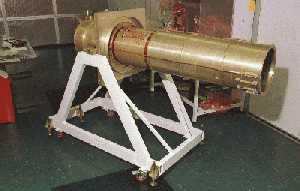


As well as its three X-ray telescopes, XMM
will incorporate one optical/UV telescope which points at the same
region of the sky. This will enable XMM to record optical images of
the X-ray sources it is studying, so that it can show the star or
galaxy from which the X-rays are coming, or whereabouts within a
galaxy they originate. This will be done with the Optical Monitor
(OM) which is a 30 cm Richey-Chretien telescope encased within a
cylindrical tube 2 m in length. The OM focuses light onto a detector
via a mirror and filter wheel, which contains various filters and
magnifiers. In order to achieve the great sensitivity needed, the OM
incorporates a Micro Channel Plate image intensifier and CCD. The
intensifier amplifies the signal by a factor of a 100,000 before it
reaches the CCD. The OM will detect 24th magnitude stars and galaxies,
comparable with what can be done with far bigger telescopes on the
ground, due to the dark skies of space. To find out more about the OM, please
click here and follow the links to
instrumentation.

